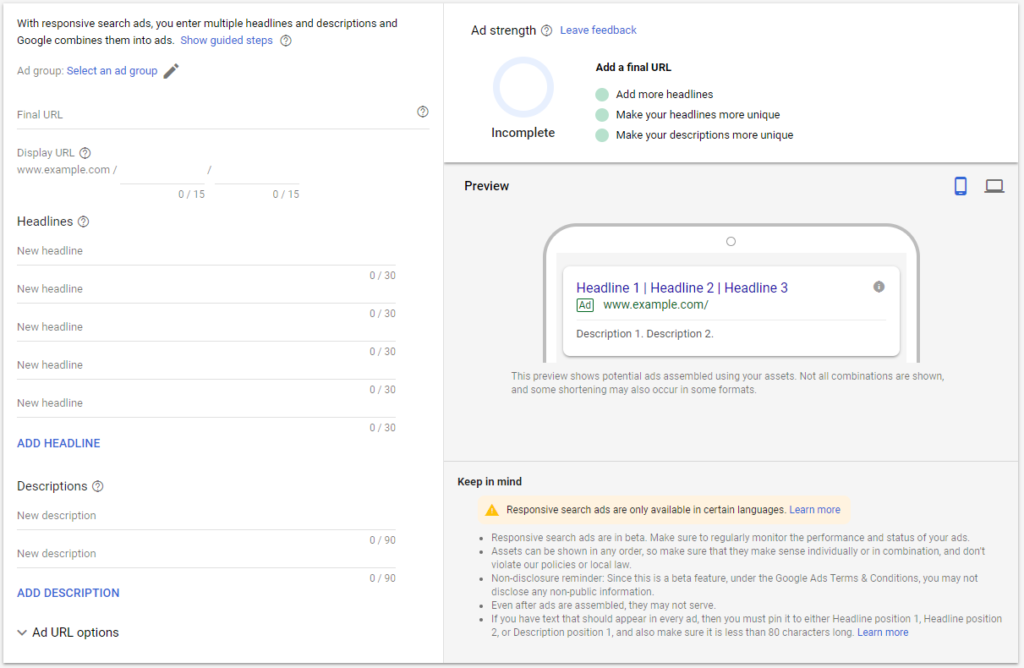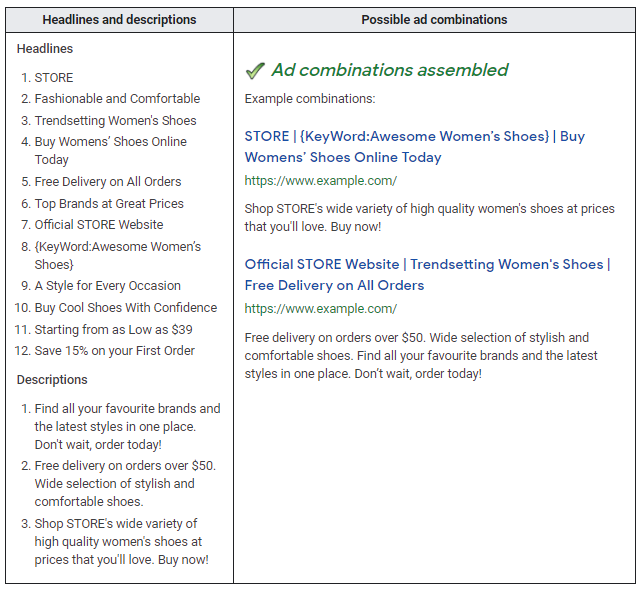How to Set Up Responsive Search Ads For Success in 2021 (+ Free Template)
Responsive search ads (RSAs) are no longer the new kid on the block. Released back in 2018, these dynamic ads have allowed us to further automate and push our ad performance to new heights.
Now, Google has showcased its strong preference for increased automation by making Responsive Search Ads the new default ad type for search campaigns. Expanded Text Ads can still be implemented within standard search campaigns – which we recommend continuing until further updates come into play.
With this latest update, we also see the capabilities of RSAs increase with the new additions to dynamic ad text. We can now implement countdown customisers within RSAs – increasing urgency across this responsive ad type.
Beyond this, Google has also released a new location insertion feature – a welcomed update to the Business Data Feeds required to implement dynamic locations within expanded text ads.
Running Responsive Search Ads alongside Expanded Text Ads can drive an uplift in click-through rate and conversions. To help you get the most out of this new Google Ads format, we are sharing our RSA best practices.
This quick five (5) step how-to guide will help you set up your Google Responsive Search Ads for success!
What are Responsive Search Ads?
Responsive Search Ads dynamically combine your headings and descriptions. Using the powers of machine learning, they automatically create multiple variations of your ad copy and find the highest performing combinations for each user.
To the user scrolling throughout the search results page, Responsive Search Ads appear the same as Expanded Text Ads. Once Google has gathered enough data on the ad assets, the advertiser quickly gathers valuable insights into the highest performing ad copy variations for their users.
1. How to Set Up Responsive Search Ads Efficiently
Here is our favourite RSA hack.
Give yourself a head start by using your existing Expanded Text Ads (ETA’s) to set up your RSA’s. Look at past ad performance and gauge which ads are performing best, using click through rate as your key metric.
You will want to ensure you include these high performing headlines and descriptions in your new responsive search ads. You will only need to implement one Responsive Search Ad per ad group.
If you have a bulky Google Ads account: Once you have selected your strongest ad variation, jump in to Adwords Editor and select these ads. Copy and paste these ads into excel and remove any duplicate ad groups. You will want to make sure you have one ETA per ad group within this document. Now it is time to build out your extra headline and descriptions. You can download our Free Responsive Search Ads Template to help you with this build.
If you’ve got a smaller Google Ads Account: You can easily build out your Responsive Search Ads on the Google Ads online platform. When you select the ad group to build to a Responsive Search Ad for, Google will automatically populate the ad using your current Expanded Text Ads. The ad strength will also give you a good indication of how well your Responsive Search Ad is written. Google will also give further suggestions if you’re ad copy is lacking.

2. How to Structure Responsive Search Ads
Responsive Search Ads allow up to 15 headlines and 4 descriptions. Although you only need a minimum of 5 headlines to upload a Responsive Search Ad, we recommend adding in at least 8-10. The more headlines you have – the more variations Google can test.
The responsive ad headlines allow for 30 characters, and as with the updated Expanded Text Ads, the descriptions have a 90-character limit. Keep in mind that the third headline and second description may not always show. Because of this, you’ll need to make sure each description can stand on its own.
3. Perfect Your Ad Copy
It is important to keep each headline and description distinct and different. When your headlines are too similar, they become redundant and this effects Google’s ability to assemble and test variations. You should also vary the length of your 15 headlines.
Looking for some Responsive Search Ad copy inspiration?
Try including some keywords, brand terms and slogans, the website URL, unique selling points (USPs), and call to actions! Remember to check your Responsive Search Ad strength (on the online platform) once you have implemented the ads.
Also check out the Google Responsive Ads example below.

Check out our expert guidelines for optimising your Google Ad copy.
4. Pinning Headlines & Descriptions
Do you have strict brand requirements? Maybe you need to ensure that your call to action displays before your USPs. Pinning gives you the opportunity to ensure that the right headlines display in your ads first.
If you need to display a certain headline at the beginning of every ad (e.g. Shop Women’s Shoes), use the pinning feature to ensure it displays in either position 1 or 2.
Here are our tips for best practice pinning:
Pinned headlines and descriptions will only show in their pinned positions. Pinning only one headline or description to a single position means that no other asset will show within that position. For example, if the asset “Women’s Shoes” is pinned to headline 1, this asset will always show for headline 1.
We recommend pinning at least two variations to a pinned position. For example, if the assets “Women’s Shoes” and “Women’s Footwear” are both pinned to headline 1, either one of these assets will always show in headline 1. By pinning many variations to a specific position, as opposed to just one asset, you give Google the opportunity to test more ad combinations.
Over-pinning your headlines and descriptions restricts the number of ad combinations available. The more you pin, the less flexible these ads are.
When it comes to pinning, our advice is to pin sparingly.
– Uncle Ben, Spiderman.
“Withpinningpower comes great responsibility”
5. Build, Review, Optimise – Repeat.
Now that RSAs are here to stay, it is important to include them within your regular optimisation checks. Google Ads now assigns your responsive search ads an ad strength, with clear recommendations to improve this rating.
Generally, you will find these recommendations give the AI further capability to test and learn with common suggestions around decreasing pinned assets and further differentiating copy options provided.
We recommend reviewing and optimising RSA ad strength and ad copy on a regular basis. This way you will achieve stronger results and higher ad rank, at a lower cost per click (CPC).
Learn more about how PPC & Google Ads can help your business today.